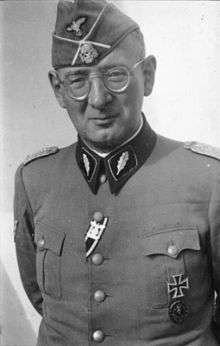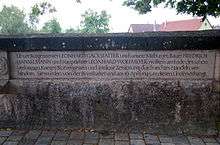Max Simon
Max Simon (6 January 1899 – 1 February 1961) was a German SS commander and war criminal during World War II. Simon was one of the first members of the SS in the early 1930s. He rose through the ranks of the SS, and became a corps commander during World War II. After the war, Simon was convicted for his role in the Marzabotto massacre.
Max Simon | |
|---|---|
 SS-Standartenführer Max Simon | |
| Born | 16 January 1899 |
| Died | 1 February 1961 (aged 62) |
| Allegiance |
|
| Branch | |
| Rank | SS-Gruppenführer and Generalleutnant of the Waffen-SS |
| Unit | SS Division Totenkopf SS Division Reichsführer-SS XIII SS Corps |
| Battles/wars | World War II |
| Awards | Knight's Cross of the Iron Cross with Oak Leaves |
Early career
Simon was born in Breslau. In 1917 he joined the army and served in the 11th Division. He served in Macedonia and on the Western Front, being awarded the Iron Cross 2nd class (1914). At the end of the war he joined the Freikorps in Silesia and fought against the Polish forces. His unit was later incorporated into the Reichswehr as the 16th Cavalry Regiment and Simon was promoted to Unterfeldwebel.
In May 1933 he joined the SS service number 83 086 and the NSDAP party number 1 350 576, and was assigned to the 47th SS-Standarte in Gera and was promoted to Untersturmführer (Second Lieutenant) in November 1934, until ordered to raise a new unit in 1935, 1st SS Totenkopfstandarte Oberbayern and given the rank of Standartenführer (Colonel). In 1934 he was appointed as the commander of the Sachsenburg concentration camp.[1] In 1938 he took part in the Anschluss of Austria, the occupation of Bohemia and Moravia and the occupation of the Sudetenland.
World War II
At the start of World War II, the SS Regiment was renamed in October 1939. The 1st SS Totenkopfstandarte Oberbayern, as the 1st Panzer Grenadier Regiment SS Totenkopf Division and was later renamed the 5th Panzer Grenadier regiment in 1943. During the Battle of France Simon, led his regiment in the capture of Pixie, Lyon, Orléans, Tours and Bordeaux and then advanced to the border with Spain.
In July 1941 Simon took part in the invasion of Soviet Union, Operation Barbarossa, as part of Army Group North, taking Kraslava and breaking through the Stalin line, where Simon was wounded. For the fighting in the Battles of the Demyansk Pocket, Simon was awarded the Knight's Cross and promoted to Oberführer (Brigadier General). In December 1942 Simon was promoted again to Brigadeführer (Major General), prior to being given command of the 16th SS Panzergrenadier Division Reichsführer-SS.
The SS Division Reichsführer-SS was to be formed in Hungary from Simon's old regiment and the Sturmbrigade Reichsführer SS.[2] In 1944 the division was moved to Italy, and fought, never complete, at Anzio and later in the Arno sector, where it gained a reputation for stability although it suffered heavy losses during the battles in the Apennines. The division also fought against partisans behind the lines, perpetrating several major atrocities against civilians (Sant'Anna di Stazzema massacre and Marzabotto massacre), for which Simon was awarded the Oakleaves for the Knight's Cross and the German Cross in Gold, in October 1944.[1]
In November 1944, Simon was promoted to was given command of the XIII SS Corps.[3] The XIII SS Corps deployed to the Lorraine region against the United States Army, and from December 1944 defended the Siegfried Line (called the Westwall by the Germans).
The XIII SS Army Corps was forced to withdraw into the Saarland and the Palatinate where it started to destroy the Rhine bridges. In April 1945 between Main and Jagst it came up against the 4th US Armored Division and took part in heavy fighting around the Tauber – Colombia line and around Würzburg and Nuremberg. The Corps then fought a withdrawal to the Danube and around Munich. On the orders of Simon the bridges over the Isar approaching Austria were not blown up, as he believed there was no need as the end of the war was near.
Killings in Brettheim

Brettheim is a village in the Schwäbisch Hall district of Baden-Württemberg. Simon ordered the execution of Friedrich Hanselmann, Leonhard Gackstatter and Leonhard Wolfmeyer for Wehrkraftzersetzung on 10 April 1945. The farmer Hanselmann had taken away the weapons of 15-year-old boys from the Hitler Youth and had thrown them into the local pond. The boys reported this to their commanding officer SS-Sturmbannführer Gottschalk, who had Hanselmann arrested. Gottschalk sentenced Hanselmann to death and asked the mayor of Brettheim, Gackstatter, and the teacher Wolfmeyer to confirm the sentence. The two men refused and were subsequently also arrested and sentenced to death. The men were executed by hanging and strung up on a tree at the entrance of the local cemetery. Simon had ordered that the bodies be left hanging for four days. On 17 April 1945 American tanks approached the village. The SS had declared Brettheim a "cornerstone of the German defense" and prevented the hoisting of white flags. The Americans opened fire, and within a short time the village became a burning inferno. 17 civilians were killed.[4]
On 1 May 1945 the Corps surrendered to the American forces.
War crimes conviction
After the war, Max Simon was sentenced to death by a British court for his part in the Marzabotto massacre. This sentence was later changed to life imprisonment. Simon was pardoned in 1954 and released from prison.
Simon was subsequently tried three times in the Federal courts for the killings in Brettheim and other crimes, but, "to the horror of the West German public," was found not guilty.[5] Simon died in 1961. Even in death, Simon caused some controversy, as HIAG, an organization of former Waffen-SS members, attempted to place a glorifying obituary for him in the German newspaper Frankfurter Allgemeine. To HIAG's indignation, the newspaper refused to run the obituary.[5]
Awards
- Clasp to the Iron Cross (1939) 2nd Class (13 September 1939) & 1st class (2 October 1939)[6]
- Knight's Cross of the Iron Cross with Oak Leaves
- German Cross in Gold on 9 October 1944 as SS-Gruppenführer and Generalleutnant of the Waffen-SS in the 16. SS-Panzergrenadier-Division "Reichsführer-SS"[9]
See also
- List SS-Gruppenführer
References
Citations
- Valhalla's Warriors By Terry Goldsworthy, p.235
- Mitcham, Samuel W. Jr. German Order of Battle, Volume 3. p. 164.
- Williamson & Bujeiro 2005, p. 31.
- "Die Männer von Brettheim". Brettheimmuseum (in German). Retrieved 30 November 2013.
- Frankfurter Allgemeine 2010.
- Thomas 1998, p. 326.
- Fellgiebel 2000, p. 401.
- Fellgiebel 2000, p. 91.
- Patzwall & Scherzer 2001, p. 446.
Bibliography
- "In Brettheim: Der SS-General und brutale "Feldgendarm" Max Simon [In Brettheim: The SS general and brutal "military policeman" Max Simon]". Frankfurter Allgemeine (in German). 2010. Archived from the original on December 9, 2015. Retrieved 2 December 2015.
- Fellgiebel, Walther-Peer (2000) [1986]. Die Träger des Ritterkreuzes des Eisernen Kreuzes 1939–1945 [The Bearers of the Knight's Cross of the Iron Cross 1939–1945] (in German). Friedberg, Germany: Podzun-Pallas. ISBN 978-3-7909-0284-6.
- Patzwall, Klaus D.; Scherzer, Veit (2001). Das Deutsche Kreuz 1941 – 1945 Band II [The German Cross 1941 – 1945 Volume 2] (in German). Norderstedt, Germany: Verlag Klaus D. Patzwall. ISBN 978-3-931533-45-8.
- Thomas, Franz (1998). Die Eichenlaubträger 1939–1945 Band 2: L–Z [The Oak Leaves Bearers 1939–1945 Volume 2: L–Z] (in German). Osnabrück, Germany: Biblio-Verlag. ISBN 978-3-7648-2300-9.
- Williamson, Gordon; Bujeiro, Ramiro (2005). Knight's Cross and Oak Leaves Recipients 1941-45. Osprey. ISBN 1-84176-642-9.CS1 maint: ref=harv (link)
External links
- "Der Spiegel berichtete ..." Der Spiegel (in German). 1960. Retrieved 24 June 2014.